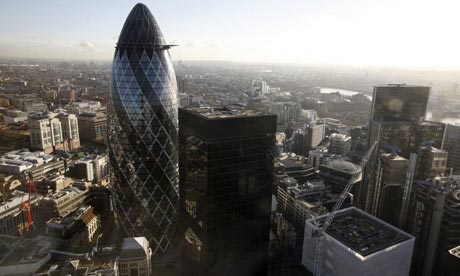Article from the Guardian by John Vidal (16th June 09) about temporary "grow gags" being moved guerrilla style across London to provide food for city dwellers.

"The local authority wants some of its 9,000 residents to use sites awaiting development to grow food in giant grow bags
The City of London has only 22 acres of open space, mostly in old burial grounds and small squares, but the recession has left many building sites vacant. Photograph: Martin Argles
The Square Mile, capital of commerce and the site of Britain's most expensive real estate, could soon host some of its first temporary allotments with giant "grow bags" set up on building sites.
The City of London, one of the few authorities not to have formal allotments, wants some of its 9,000 residents to use the spaces to grow fruit and vegetables. The authority has only 22 acres of open space, mostly in old burial grounds and small squares, but the recession has left many building sites vacant.
"There are plenty of temporary sites awaiting development and there is no reason why, if carefully done, they could not be turned to other uses," said Sue Ireland, head of open spaces in the City.
"We are trying to identify a site on the edge of the Square Mile that would be vacant for between 18 months and two years. Grow bags are one possibility. They could be butted up together and moved as and when the developers need to start work."
The grow bags idea came from a music festival where she saw huge sandbags being moved around by fork-lift trucks. "I was thinking how flexible they could be. Grow bags would allow people to grow carrots and peas. You would have to secure the site and give developers the confidence that the bags could be moved. But if the right site came up, I am sure money would be available."
The idea of using temporary sites to grow food is not new. In New York, community gardeners have moved from one site to another for more than 30 years.
The Commission on Architecture and the Built Environment (Cabe) calculates that Britain has nearly 74,100 acres of vacant or derelict brownfield land and other unused public space that could enhance cities or help communities.
"Other cities have guerrilla gardens, why not guerrilla allotments?" says Sarah Gaventa, director of the Cabe Space, the government's official adviser on public space, who is a resident of the City of London. "There is lots of dead space in the Square Mile. It's ridiculous not to use it for local food production.
Chris Baines, an ecologist and author, added: "Land 'in limbo' is an incredibly valuable resource. Its temporariness is its strength. It allows you to be more innovative because you know it is not going to be permanent."
The City of London initiative follows dozens of other grassroots projects to grow food in cities where allotment space is at a premium and there is growing demand for local food. Yesterday it was revealed that the Queen had turned over an allotment-sized plot for growing vegetables and fruit in the gardens of Buckingham Palace.
Many inner-London boroughs have waiting lists for allotments that can be decades long and there is a reported shortage of more than 200,000 allotments across Britain.
Boris Johnson, mayor of London, and Rosie Boycott, chair of London Food, have recently launched a scheme to turn over 2,000 pieces of land in London into space for food growing by 2012. Thirteen organisations, including British Waterways, councils, schools, hospitals, housing estates, and companies have pledged to make land available for community gardening schemes. Both the National Trust and the Royal Parks have agreed to provide allotment space.
But the City is way behind the competition. The UN estimates that 15-20% of the food produced in the world now comes from 800 million urban and peri-urban farmers and gardeners in cities"
Full article from the Guardian here
-----
Via Metabolicity

